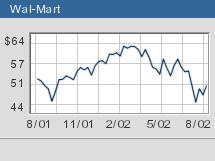NEW YORK (CNN/Money) -
Wal-Mart's second-quarter profit jumped 23 percent from a year earlier to beat Wall Street estimates, the company said Tuesday, and it raised third-quarter earnings expectations.
But the world's biggest retailer lowered the bar on sales and earnings beyond the third quarter amid worrisome economic news, which some analysts believe is now affecting sales at discount chains. And that could make Wal-Mart's stock vulnerable, said Bill Dreher, a retail analyst at W.R. Hambrecht & Co.
"The stock is manipulated by perceptions of the future, and investors are very concerned right now that the economy is weaker than we thought," Dreher said. "Wal-Mart is doing a superb job. On other the hand, the stock is vulnerable."
Dow component Wal-Mart left its full-year earnings forecast alone even though it raised the third-quarter outlook. The company acknowledges that sales are running at a slower pace than a few months ago, but Chairman Lee Scott told investors Tuesday that Wal-Mart attributes the slowdown to summer seasonal changes more than to economic turbulence or consumer confidence.

Wal-Mart's (WMT: up $1.59 to $50.00, Research, Estimates) shares headed higher in Tuesday afternoon trading after the earnings report. The stock, which is up 16.3 percent since last September, trades at 26 times 2002 earnings estimates and 23 times 2003 earnings estimates, Dreher said. That's a premium valuation on a company which could be vulnerable if consumers tighten their belts, he observed.
For the quarter ended July 31, Wal-Mart reported earnings of $2 billion, or 46 cents a share, up from $1.6 billion, or 37 cents, a year earlier. Analysts on average expected 45 cents a share, according to earnings tracker First Call.
Net income increased to $3.7 billion, or 83 cents a share, from $3 billion, or 67 cents, a year earlier.
Sales jumped 13.1 percent to $60 billion. The Bentonville, Ark.-based chain, which also operates the Sam's Club wholesale warehouses, said Monday August sales at stores open at least a year, a key gauge known as same-store sales, are on track to meet company expectations of a 4-to-6 percent increase. Wal-Mart had been forecasting 5-to-7 percent monthly same-store sales increases for the last several months.
Wal-Mart raised its third-quarter earnings guidance to 40 or 41 cents a share, officials told analysts in a pre-recorded telephone message Tuesday after the earnings report, and reiterated full-year guidance of $1.76 to $1.78 a share. Third-quarter sales are on track for a 4-to-6 percent increase.
Some analysts have said Wal-Mart's moderated sales expectations do reflect growing unease among consumers, whose spending makes up two-thirds of the economy. If that persists, it could have a serious impact in the critical December holiday season.
"They are admitting they have very cloudy visibility on the very critical holiday season," Dreher said of Wal-Mart's revised guidance. "What might be more significant to investors is that even though they had an admittedly superb second quarter, where are we going from here?"
Wal-Mart isn't the only one affected by the economy. Overall moderate sales growth was reflected in the latest data from the Commerce Department Tuesday, which said July retail sales, excluding volatile auto sales, increased just 0.2 percent.
In its second quarter report Tuesday, Wal-Mart said same-store sales for the quarter increased 6.4 percent from a year earlier. Sales increased 7.1 percent at the company's core Wal-Mart division and 3.4 percent at Sam's Club.
"For the first time in our history, we generated over $2 billion in net income in a non-holiday quarter," Chairman Scott said.
The strongest sales in Wal-Mart's second quarter came in the company's Wal-Mart stores and International divisions with gains of 14.1 percent and 15.9 percent, respectively. But higher insurance and legal costs, along with higher benefit costs, caused second-quarter expenses to increase.
| |
 Related stories/sites
Related stories/sites
| |
| | |
| | |
|
The company's gross margin as a percentage of inventory, that is the amount of money it made on each sale after factoring in costs, increased by 30 basis points in the quarter. Wal-Mart said fewer markdowns and less shrinkage helped boost margins. Shrinkage refers to merchandise that is damaged or stolen in the normal course of handling. Improved store operations also bolstered profit, the company said.

|

